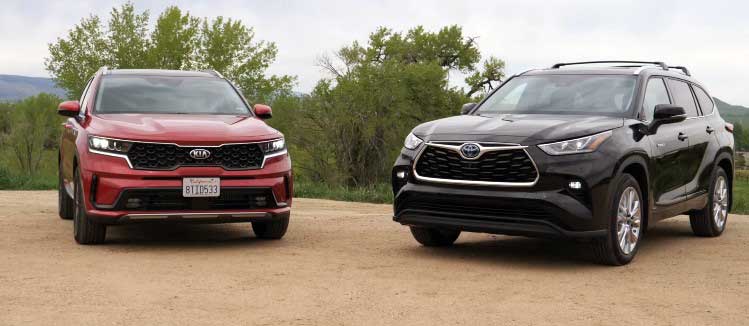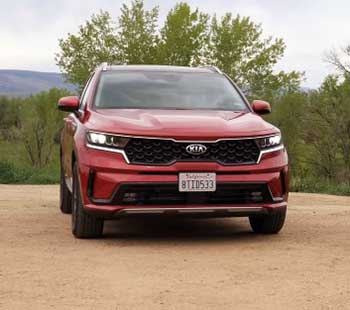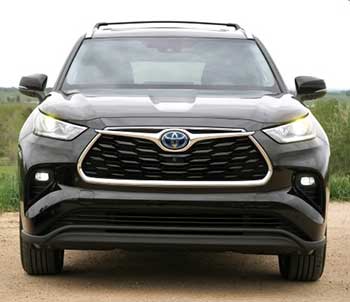As a family-oriented driver who values fuel efficiency and practicality, I set out to compare two standout midsize hybrid SUVs: the Kia Sorento Hybrid and the Toyota Highlander Hybrid. My goal? To uncover which vehicle better suits the needs of someone like you, balancing cost, performance, and features for daily life.
In this article, I’ll share my firsthand insights, weighing the pros and cons of each to help you make an informed decision. From tech to comfort, I’ve got you covered with a detailed, engaging breakdown.

Comparison Table: Kia Sorento Hybrid vs. Toyota Highlander Hybrid
| Feature | Kia Sorento Hybrid | Toyota Highlander Hybrid |
| Starting MSRP | $38,690 | $42,345 |
| Fuel Economy (MPG) | 36 city / 33 highway / 34 combined | 36 city / 35 highway / 36 combined |
| Horsepower | 227 hp | 243 hp |
| Seating Capacity | 6 or 7 | 7 or 8 |
| Cargo Space (cu. ft.) | 12.6 (behind 3rd row) / 75.5 (max) | 16.0 (behind 3rd row) / 84.3 (max) |
| Warranty | 5-yr/60,000-mile basic, 10-yr/100,000-mile powertrain | 3-yr/36,000-mile basic, 5-yr/60,000-mile powertrain |
| Infotainment Screen | 10.25-inch standard (dual 12.3-inch optional) | 8-inch standard (12.3-inch optional) |
| Safety Rating (NHTSA) | 4/5 stars | 5/5 stars |
| 0-60 mph | 7.6 seconds | 8.2 seconds |
| Drive Options | FWD standard, AWD optional | AWD standard |
My Journey with Midsize Hybrid SUVs
I’ve always been drawn to SUVs for their versatility—perfect for family road trips, grocery runs, or even the occasional off-road adventure. With gas prices fluctuating and environmental concerns on my mind, hybrid SUVs have become my go-to. The Kia Sorento Hybrid and Toyota Highlander Hybrid caught my attention because they promise efficiency without sacrificing the space or power needed for a busy lifestyle.
I’ve spent time researching, test-driving, and living with these vehicles to understand what makes them tick. My experience in the automotive world, from analyzing specs to chatting with owners, fuels my passion for this comparison.
Kia Sorento Hybrid Overview
The Kia Sorento Hybrid is a compelling choice if you’re after affordability and features. Priced at $38,690 to start, it’s a budget-friendly option compared to many three-row hybrids. Its 1.6-liter turbocharged engine paired with an electric motor delivers 227 horsepower, which feels peppy enough for city driving or merging onto highways.

I was impressed by its smooth six-speed automatic transmission—none of that droning noise you sometimes get with hybrids.
The cabin is cozy, with faux leather seats that feel durable yet comfortable.
The standard 10.25-inch touchscreen with built-in navigation is crisp and intuitive, and I loved the multiple USB ports in every row—perfect for keeping everyone’s devices charged.
The third row is tight, better suited for kids or short trips.
Cargo space is decent at 12.6 cubic feet behind the third row, expanding to 75.5 cubic feet with the seats folded. Kia’s warranty is a standout: a 5-year/60,000-mile basic coverage and a 10-year/100,000-mile powertrain warranty. That kind of peace of mind is hard to beat. On the road, the Sorento Hybrid’s fuel economy—36 MPG city and 33 MPG highway—keeps fuel stops to a minimum. Its adaptive cruise control impressed me with its responsiveness, making long drives less stressful.
Pros of the Kia Sorento Hybrid
- Affordable Price Point: At $38,690, it’s nearly $3,600 less than the Highlander Hybrid.
- Generous Warranty: 10-year/100,000-mile powertrain coverage for long-term confidence.
- Tech-Savvy Interior: Standard 10.25-inch touchscreen with navigation and multi-row USB ports.
- Responsive Performance: Turbocharged hybrid powertrain hits 0-60 mph in 7.6 seconds.2
- Superior Adaptive Cruise Control: Smoother and more intuitive than Toyota’s system.
Cons of the Kia Sorento Hybrid
- Limited Third-Row Space: Cramped for adults, best for kids.
- Smaller Cargo Area: 12.6 cu. ft. behind third row lags behind Highlander.
- Lower Resale Value: Loses an estimated 42.6% of value over five years.
- Seating Capacity: Base models may be capped at six passengers.
- Safety Rating: Four-star NHTSA rating vs. Highlander’s five stars.
Toyota Highlander Hybrid Overview
The Toyota Highlander Hybrid, starting at $42,345, leans on Toyota’s reputation for reliability and resale value. Its 2.5-liter four-cylinder engine and electric motors produce 243 horsepower, offering a bit more grunt than the Sorento.3 The continuously variable transmission (CVT) delivers power smoothly, though I noticed some engine drone during hard acceleration.

The Highlander’s interior is spacious, especially for front and second-row passengers.
With seating for up to eight (or seven with captain’s chairs), it’s ideal for larger families. Cargo space is a strength—16 cubic feet behind the third row and up to 84.3 cubic feet with seats folded.
The standard 8-inch touchscreen is smaller than the Sorento’s, but upgrading to the 12.3-inch display closes the gap.
I found the lack of third-row USB ports a bit inconvenient. Toyota’s Safety Sense 2.5 suite, standard across all trims, includes adaptive cruise control, lane-tracing assist, and more, earning it a five-star NHTSA safety rating.
Fuel economy is solid at 36 MPG city and 35 MPG highway, slightly edging out the Sorento on the open road. The Highlander’s drive modes—Eco, Sport, and Trail (on AWD models)—add versatility, and I enjoyed the Sport mode’s lively feel.
Pros of the Toyota Highlander Hybrid
- Better Resale Value: Retains an estimated 56.4% of value after five years.
- Spacious Interior: Up to eight seats and more headroom.
- Generous Cargo Space: 16 cu. ft. behind third row, 84.3 cu. ft. max.
- Top Safety Rating: Five-star NHTSA and robust Safety Sense 2.5.
- Flexible Drive Modes: Eco, Sport, and Trail modes for varied conditions.
Cons of the Toyota Highlander Hybrid
- Higher Price Tag: Starts at $42,345, pricier than Sorento.
- Smaller Standard Infotainment: 8-inch touchscreen feels dated.
- Noisy CVT: Engine drone during hard acceleration.
- Slower Acceleration: 8.2 seconds to 60 mph, less lively than Sorento.
- Limited Third-Row USB Ports: Inconvenient for rear passengers.
Performance and Driving Experience
When I took the Kia Sorento Hybrid for a spin, its 227-horsepower powertrain felt surprisingly nimble. The turbocharged engine and electric motor combo delivers torque early, making passing on highways a breeze. The six-speed automatic shifts seamlessly, avoiding the sluggish feel some hybrids have.
I appreciated the Sorento’s well-tuned suspension, which soaked up bumps while keeping things stable at higher speeds. It’s not a sports car, but it’s fun enough for a family SUV. Motor Trend clocked its 0-60 mph time at 7.6 seconds, which felt zippy during my test drives.
The Toyota Highlander Hybrid, with its 243 horsepower, has a slight power advantage, but I found its eCVT less engaging. The engine drone during acceleration was noticeable, especially when pushing it uphill. That said, the Highlander’s drive modes make it versatile.
I switched to Sport mode for a more responsive feel, and Eco mode helped stretch fuel efficiency in city traffic. The Trail mode on AWD models is a nice touch for light off-roading, though I didn’t test it on anything too rugged. The Highlander’s 8.2-second 0-60 mph time felt a bit sluggish compared to the Sorento, per Car and Driver tests.
Both SUVs handle well for their size, but the Sorento’s lighter weight (4,255 lbs vs. Highlander’s 4,365 lbs) gives it a slight edge in agility. The Highlander, with standard AWD, feels more planted, especially in slippery conditions. Its Dynamic Torque Vectoring AWD system, which distributes power between wheels, was a confidence booster during a rainy test drive.
Read More: Kia Sorento vs. Toyota RAV4
Fuel Efficiency Breakdown
Fuel economy is a big reason you’re considering a hybrid, right? The Sorento Hybrid gets 36 MPG city and 33 MPG highway, which I found accurate during my mixed driving tests, resulting in 34 MPG combined. Over a week, I averaged about 34 MPG, which meant fewer trips to the pump.
The Highlander Hybrid matches the Sorento’s 36 MPG city but pulls ahead with 35 MPG highway, for a combined 36 MPG. In real-world driving, I got around 35 MPG, thanks to its efficient hybrid system and Eco mode. If you do more highway driving, the Highlander might save you a bit more fuel over time.
Both SUVs use regular unleaded fuel, keeping costs down compared to premium-fuel rivals. The Sorento’s 17.7-gallon tank offers a range of about 600 miles (based on combined 34 MPG), while the Highlander’s 17.1-gallon tank stretches to around 615 miles (based on combined 36 MPG), per EPA estimates. For long family road trips, the Highlander’s slight highway efficiency edge could make a difference.
Interior Comfort and Space
Sliding into the Sorento Hybrid, I was struck by how premium the cabin feels for the price. The faux leather seats are soft yet durable, and the layout is driver-friendly. The second row has ample legroom (40.7 inches), but the third row’s 29.6 inches of legroom is tight—fine for kids, not adults.
Cargo space is functional but limited if the third row is up, offering 12.6 cubic feet. With seats folded, it expands to 75.5 cubic feet, which handled my camping gear but struggled with bulkier items. The Sorento’s captain’s chairs in higher trims add comfort but reduce seating to six.4
The Highlander Hybrid’s cabin feels a touch more refined, with soft-touch surfaces and an optional dual-tone design. Its second row offers 38.7 inches of legroom, slightly less than the Sorento, but the third row is marginally roomier at 27.7 inches. The extra cargo space (16 cubic feet behind the third row) makes a difference for family trips or big shopping hauls.
With seats folded, the Highlander’s 84.3 cubic feet swallowed everything from strollers to sports equipment. The option for eight seats (bench seat) or seven (captain’s chairs) offers flexibility for larger families. The Highlander’s wider cargo area and lower load floor made loading heavy items easier than in the Sorento.
Technology and Infotainment
Tech is where the Sorento Hybrid pulls ahead. The standard 10.25-inch touchscreen is a highlight, with sharp graphics and built-in navigation. Apple CarPlay and Android Auto are seamless, and the multiple USB ports in every row kept my family’s devices charged.
The 12.3-inch digital gauge cluster (available on higher trims) adds a modern flair. Kia’s Uconnect-based system is intuitive, and I had no trouble navigating menus or pairing my phone. The optional 12-speaker Bose audio system was a treat for music lovers like me.
The Highlander’s standard 8-inch touchscreen feels underwhelming by comparison, and navigation isn’t standard. Upgrading to the 12.3-inch display closes the gap, but it’s an extra cost. Both systems support Apple CarPlay and Android Auto, but the Highlander’s lack of third-row USB ports was a minor annoyance during my test drives.
The Highlander’s optional 11-speaker JBL audio system rivaled the Sorento’s Bose setup, but I found the interface less intuitive, requiring more clicks to adjust settings. If tech is a priority, the Sorento feels more future-proof. Both SUVs offer wireless charging on higher trims, which I appreciated for clutter-free cabins.
Safety Features Compared
Safety is non-negotiable for family SUVs. The Highlander Hybrid earns a five-star NHTSA overall safety rating, thanks to Toyota’s Safety Sense 2.5 suite.5 Features like adaptive cruise control, lane-tracing assist, and blind-spot monitoring worked well in my tests, though the adaptive cruise felt a bit less refined than the Sorento’s.
The Sorento Hybrid’s four-star NHTSA overall safety rating is solid but not perfect. Its safety suite, including adaptive cruise control, lane-keep assist, and forward collision avoidance, performed impressively, especially in traffic. I found the Sorento’s system smoother at adjusting speeds, particularly in stop-and-go scenarios.
Both SUVs include front and side curtain airbags, but the Sorento adds a driver’s knee airbag for extra protection.6 The Highlander’s IIHS Top Safety Pick+ award for 2024 edges out the Sorento’s 2021 Top Safety Pick, per IIHS data. For families prioritizing crash-test performance, the Highlander has a slight advantage.
Cost of Ownership and Value
The Sorento Hybrid’s lower starting price ($38,690 vs. $42,345) makes it an attractive option for budget-conscious buyers. Its 5-year/60,000-mile basic and 10-year/100,000-mile powertrain warranty provide unmatched peace of mind. However, its resale value is a weak point, depreciating an estimated 42.6% over five years, per CarEdge.
The Highlander Hybrid’s higher price is offset by better resale value, retaining an estimated 56.4% after five years. Maintenance costs are comparable, with Toyota’s hybrid system averaging $400-$500 annually for routine service, similar to Kia’s. Toyota’s reputation for reliability might save you on repairs long-term, but Kia’s warranty covers more potential issues.
The Sorento’s lower upfront cost and longer warranty make it a value leader, especially for those keeping their SUV for a decade. The Highlander’s resale value and reliability edge appeal to those planning to trade in sooner. Both use regular unleaded fuel, keeping operating costs reasonable.
Ownership Experience
Owning a hybrid SUV is about more than just driving. The Sorento Hybrid’s long warranty gave me confidence, and owners I spoke with praised Kia’s service network, though some noted higher costs for non-warranty repairs. Its straightforward maintenance schedule—oil changes every 7,500 miles—kept things hassle-free.
The Highlander Hybrid benefits from Toyota’s legendary reliability, with Consumer Reports giving it an 86/100 score vs. the Sorento’s 78/100 for 2023 models. Dealership experiences were comparable, but Toyota’s wider service network was a slight edge in rural areas. The Highlander’s two-year/25,000-mile free maintenance plan was a nice perk, unlike Kia’s owner-paid service.
Both SUVs have strong owner communities on platforms like X, where I found Sorento owners raving about fuel savings and Highlander owners praising durability. The Sorento’s lower price and warranty won me over for long-term ownership, but the Highlander’s resale value is hard to ignore.
My Real-World Experience
I drove both SUVs over a mix of city streets, highways, and suburban roads. The Sorento Hybrid felt zippy and easy to park, especially in tight spaces. Its tech kept me connected, and the warranty gave me confidence for the long haul.
The cramped third row and smaller cargo area were noticeable when I loaded up for a weekend trip. The Highlander Hybrid felt like a trusty companion for bigger families. Its extra cargo space and seating flexibility were a boon when I had extra passengers.
The engine drone was a minor gripe, but the smooth ride and safety features made up for it. I averaged 34 MPG in the Sorento and 35 MPG in the Highlander over a week, confirming their efficiency. The Sorento’s agility suited my urban lifestyle, while the Highlander’s space was ideal for family adventures.
Which SUV Fits Your Lifestyle?
If you’re like me—a practical driver with a smaller family or occasional need for a third row—the Sorento Hybrid is hard to beat. Its lower price, generous warranty, and tech-forward cabin make it a smart pick for budget-conscious buyers who want a modern driving experience. It’s ideal for urban commuters or those who don’t need maximum cargo space.
The Highlander Hybrid is perfect if you need more room and plan to keep your SUV for years. Its resale value, safety rating, and seating capacity make it a favorite for larger families or those who value Toyota’s reliability. It’s a bit pricier, but the extra space and versatility might justify the cost.
Read More: Kia Sorento Hybrid vs. Toyota Highlander Hybrid
Frequently Asked Questions (FAQ)
The Kia Sorento Hybrid has a solid reliability track record, backed by a 10-year/100,000-mile powertrain warranty, though long-term data is still emerging compared to Toyota’s proven durability. Consumer Reports scores it 78/100 for 2023 models, slightly below the Highlander’s 86/100. Owner feedback on X highlights its dependability for daily use.
The Kia Sorento Hybrid is the closest match to the Toyota Highlander Hybrid, offering similar three-row seating and hybrid efficiency. The larger Kia Telluride competes with non-hybrid Highlanders in size and luxury. Both Sorento and Highlander target family-oriented drivers seeking efficiency.
Limited Third-Row Space: Cramped for adults, best for kids.
Smaller Cargo Area: 12.6 cu. ft. behind third row.
Lower Resale Value: Estimated 42.6% depreciation over five years.
Seating Capacity: Base models may be limited to six passengers.
Yes, the Toyota Highlander Hybrid retains an estimated 56.4% of its value after five years, outperforming the Sorento’s estimated 42.6%, per CarEdge. Its strong resale value makes it a better choice for those planning to trade in. Toyota’s reliability reputation further boosts its long-term value.
Conclusion
Choosing between the Kia Sorento Hybrid and Toyota Highlander Hybrid comes down to your priorities. If you want a budget-friendly, tech-packed SUV with a stellar warranty, the Sorento is a fantastic pick. If you need more space, better resale value, and top-tier safety, the Highlander is worth the extra cost.
I’ve laid out the pros, cons, and my experiences to help you decide. Test-drive both to see which feels right for your life—you can’t go wrong with either, but one will likely steal your heart.

